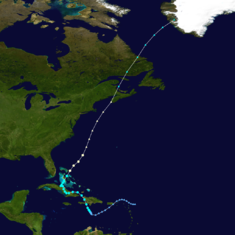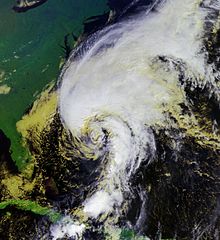- Meteorological history of Hurricane Noel
-
Hurricane Noel Category 1 hurricane (SSHS)
The path of Hurricane NoelFormed October 28, 2007 Dissipated November 4, 2007 Highest
winds85 mph (140 km/h) (1-minute sustained) Lowest pressure 966 mbar (hPa; 28.54 inHg) Areas affected U.S. Virgin Islands, Puerto Rico, Dominican Republic, Haiti, Bahamas, much of the eastern United States (Florida landfall) Part of the
2007 Atlantic hurricane seasonHurricane Noel was the fourteenth named storm and sixth hurricane of the 2007 Atlantic hurricane season. Noel formed on October 27 from the interaction between a tropical wave and an upper-level low in the north-central Caribbean Sea. It strengthened to winds of 60 mph (95 km/h) before making landfall on western Haiti and the north coast of eastern Cuba. It turned northward, and on November 1 it attained hurricane status. The hurricane accelerated northeastward after crossing the Bahamas, and on November 2 it became an extratropical cyclone. The Canadian Hurricane Centre classified Noel as a post-tropical storm until 2200 UTC November 4 when it determined that it had lost all tropical characteristics.
Contents
Formation
A tropical wave moved off the coast of Africa on October 16.[1] It tracked westward, and by October 22 the wave was approaching the Lesser Antilles with cyclonic turning and scattered convection; at the same time, an upper-level low pressure area was located to the north of the Leeward Islands.[2] The interaction between the wave and the low produced a large mass of disturbed weather on October 23,[3] and by the next day the system contained a well-defined low-level circulation about 100 miles (160 km) east-northeast of the northern Leeward Islands.[4] Despite unfavorable wind shear, convection increased as barometric pressures dropped in association with the organizing system.[5]
The low pressure area produces heavy rainfall while tracking west-southwestward through the northern Leeward Islands and eastern Puerto Rico,[6] and its convection initially remained disorganized.[7] The thunderstorm activity organized further, with an area of thunderstorm activity to the east of the partially exposed circulation; based on its organization, the National Hurricane Center classified the system as Tropical Depression Sixteen early on October 28 while located about 195 miles (310 km) south-southeast of Port-au-Prince, Haiti. Initially, the depression was forecast to track west-northwestward, brushing southwestern Haiti before moving ashore along south-central Cuba.[8]
Caribbean landfalls
Upon becoming a tropical cyclone, the wave was moving to the west-northwest under the steering currents of a high pressure area over the western Atlantic Ocean.[8] Six hours after formation, the center became difficult to locate,[9] though subsequently the depression became much better organized; a large area of convection developed over the center, with several rainbands to its south.[10] Based on reports from Hurricane Hunters, the National Hurricane Center upgraded the depression to Tropical Storm Noel at 1815 UTC on October 28 while located about 150 miles (235 km) south-southeast of Port-au-Prince, Haiti.[11] After the center re-developed beneath the thunderstorms, the storm quickly strengthened to winds of 60 mph (95 km/h),[12] and for several hours the cyclone was drifting to the south of Hispaniola. Noel began to lose organization as a nearby upper-level low increased wind shear,[13] with the circulation becoming ill-defined as it further interacted with the mountainous terrain of Haiti.[14]
The storm crossed western Haiti as a disorganized tropical storm on October 29,[15] and subsequently began moving parallel to the northeastern coast of Cuba while moving around the southwestern periphery of a weakening ridge.[16] On October 30, Tropical Storm Noel made landfall near Gibara, Cuba, with winds of about 60 mph (95 km/h).[17][18]
The center of Noel remained well-organized as it tracked through eastern Cuba, though its sustained winds quickly diminished to minimal tropical storm force.[19] Early on October 31 it began drifting to the north-northwest, in response to the approach of a short-wave trough from the west and the eastward shift of the mid-level ridge.[20] A large area of strong convective rainbands persisted to its east, though due to increased upper-level wind shear there was little convection near the center.[21] Shortly after 1200 UTC on October 31, Noel emerged off the north coast of Cuba,[22] and subsequently the cyclone became better organized as the circulation became better associated with the convection.[23] While located just off the north coast of Cuba, the motion of Noel was nearly stationary, though forecasters indicated it could have executed a small cyclonic loop.[24] On October 31, the Canadian Hurricane Centre began tracking the storm.[25]
Extratropical transition and demise
Convection increased early on November 1, though initially the center remained to the southwest of the large area of thunderstorms.[26] At 1800 UTC that day, the storm passed over the Bahamian island of New Providence near the city of Nassau.[27] Later that day the center tracked beneath the convection,[28] and Noel accelerated northeastward in the southwesterly flow ahead of an approaching trough; as it did so, the center became elongated and distorted.[29] The cyclone maintained a large, round area of deep convection with well-defined outflow, and an eye feature became evident on satellite imagery. Based on reports from Hurricane Hunters, the National Hurricane Center upgraded Noel to hurricane status early on November 2 about 180 miles (285 km) north-northeast of Nassau, Bahamas.[30] Its convection began to wane as it moved through progressively cooler waters, and as it lost tropical characteristics its wind field expanded.[31] By late on November 2, the inner core had substantially diminished, and the thermodynamical structure of the cyclone had become asymmetrical and frontal; as it began transitioning into an extratropical cyclone, the National Hurricane Center issued the final advisory on Hurricane Noel.[32]
Early on November 3, the extratropical cyclone attained winds of 85 mph (140 km/h), and it gradually turned to the north-northeast.[33] As the center of Noel approached Nova Scotia, its large circulation produced strong winds across all of Atlantic Canada and New England,[34] and on November 4 it tracked across Nova Scotia and New Brunswick.[35] At 6 PM AST (2200 UTC) November 4, as the storm was over Labrador, the Canadian Hurricane Center declared that Noel has lost all tropical characteristics and changed its designation from post-tropical to extratropical. [36] The extratropical low continued to the northeast and made landfall over southwest Greenland on the afternoon of November 5, bringing tropical storm force winds to the area. The center dissipated over Greenland later that night. While its lowest barometric pressure as a tropical system was 980 mb, on November 4, while located near Labrador, it registered a minimum pressure of 966 mb.[37]
See also
References
- ^ Beven, Brown, and Blake (2007). "October 2007 Monthly Tropical Summary". National Hurricane Center. http://www.nhc.noaa.gov/archive/2007/tws/MIATWSAT_oct.shtml?. Retrieved 2007-11-01.
- ^ Formosa (2007). "October 22 Tropical Weather Discussion". National Hurricane Center. ftp://ftp.met.fsu.edu/pub/weather/tropical/Atl-Dis/2007102300.AXNT20. Retrieved 2007-10-27.
- ^ Beven (2007). "October 23 Tropical Weather Outlook". National Hurricane Center. ftp://ftp.met.fsu.edu/pub/weather/tropical/Outlook-A/2007102309.ABNT20. Retrieved 2007-10-27.
- ^ Rhome (2007). "October 24 Tropical Weather Outlook". National Hurricane Center. ftp://ftp.met.fsu.edu/pub/weather/tropical/Outlook-A/2007102415.ABNT20. Retrieved 2007-10-27.
- ^ Mainelli (2007). "October 25 Tropical Weather Outlook". National Hurricane Center. ftp://ftp.met.fsu.edu/pub/weather/tropical/Outlook-A/2007102521.ABNT20. Retrieved 2007-10-27.
- ^ Mainelli (2007). "October 26 Tropical Weather Outlook". National Hurricane Center. ftp://ftp.met.fsu.edu/pub/weather/tropical/Outlook-A/2007102609.ABNT20. Retrieved 2007-10-27.
- ^ Beven (2007). "October 27 Tropical Weather Outlook". National Hurricane Center. ftp://ftp.met.fsu.edu/pub/weather/tropical/Outlook-A/2007102709.ABNT20. Retrieved 2007-10-27.
- ^ a b Beven (2007). "Tropical Depression Nineteen Discussion One". National Hurricane Center. http://www.nhc.noaa.gov/archive/2007/al16/al162007.discus.001.shtml?. Retrieved 2007-10-27.
- ^ Franklin (2007). "Tropical Depression Nineteen Discussion Two". National Hurricane Center. http://www.nhc.noaa.gov/archive/2007/al16/al162007.discus.002.shtml?. Retrieved 2007-10-28.
- ^ Knabb (2007). "Tropical Depression Nineteen Discussion Three". National Hurricane Center. http://www.nhc.noaa.gov/archive/2007/al16/al162007.discus.003.shtml?. Retrieved 2007-10-28.
- ^ Knabb (2007). "Tropical Storm Noel Special Discussion Four". National Hurricane Center. http://www.nhc.noaa.gov/archive/2007/al16/al162007.discus.004.shtml?. Retrieved 2007-10-28.
- ^ Knabb (2007). "Tropical Storm Noel Discussion Five". National Hurricane Center. http://www.nhc.noaa.gov/archive/2007/al16/al162007.discus.005.shtml?. Retrieved 2007-10-30.
- ^ Pasch & Roberts (2007). "Tropical Storm Noel Discussion Six". National Hurricane Center. http://www.nhc.noaa.gov/archive/2007/al16/al162007.discus.006.shtml?. Retrieved 2007-10-30.
- ^ Franklin (2007). "Tropical Storm Noel Discussion Eight". National Hurricane Center. http://www.nhc.noaa.gov/archive/2007/al16/al162007.discus.007.shtml?. Retrieved 2007-10-30.
- ^ Knabb & Mainelli (2007). "Tropical Storm Noel Discussion Eight". National Hurricane Center. http://www.nhc.noaa.gov/archive/2007/al16/al162007.discus.008.shtml?. Retrieved 2007-10-30.
- ^ Pasch & Roberts (2007). "Tropical Storm Noel Discussion Ten". National Hurricane Center. http://www.nhc.noaa.gov/archive/2007/al16/al162007.discus.010.shtml?. Retrieved 2007-10-30.
- ^ Avila (2007). "Tropical Storm Noel Discussion Eleven". National Hurricane Center. http://www.nhc.noaa.gov/archive/2007/al16/al162007.discus.011.shtml?. Retrieved 2007-10-30.
- ^ Avila (2007). "Tropical Storm Noel Public Advisory Eleven". National Hurricane Center. http://www.nhc.noaa.gov/archive/2007/al16/al162007.public.011.shtml?. Retrieved 2007-10-30.
- ^ Knabb & Landsea (2007). "Tropical Storm Noel Discussion Thirteen". National Hurricane Center. http://www.nhc.noaa.gov/archive/2007/al16/al162007.discus.013.shtml?. Retrieved 2007-10-31.
- ^ Pasch & Blake (2007). "Tropical Storm Noel Discussion Fourteen". National Hurricane Center. http://www.nhc.noaa.gov/archive/2007/al16/al162007.discus.014.shtml?. Retrieved 2007-10-31.
- ^ Beven (2007). "Tropical Storm Noel Discussion Fifteen". National Hurricane Center. http://www.nhc.noaa.gov/archive/2007/al16/al162007.discus.015.shtml?. Retrieved 2007-10-31.
- ^ Franklin & Landsea (2007). "Tropical Storm Noel Public Advisory Fifteen-A". National Hurricane Center. http://www.nhc.noaa.gov/archive/2007/al16/al162007.public_a.015.shtml?. Retrieved 2007-10-31.
- ^ Franklin (2007). "Tropical Storm Noel Discussion Sixteen". National Hurricane Center. http://www.nhc.noaa.gov/archive/2007/al16/al162007.discus.016.shtml?. Retrieved 2007-10-31.
- ^ Franklin (2007). "Tropical Storm Noel Discussion Seventeen". National Hurricane Center. http://www.nhc.noaa.gov/archive/2007/al16/al162007.discus.017.shtml?. Retrieved 2007-10-31.
- ^ Bowyer (2007). "Tropical Storm Noel Information Statement at 9:00 AM EDT on October 31". Canadian Hurricane Centre. http://www.ns.ec.gc.ca/weather/hurricane/bulletins/20071031114803.Noel.txt.en. Retrieved 2007-11-02.
- ^ Avila (2007). "Tropical Storm Noel Discussion Eighteen". National Hurricane Center. http://www.nhc.noaa.gov/archive/2007/al16/al162007.discus.018.shtml?. Retrieved 2007-11-02.
- ^ Franklin (2007). "Tropical Storm Noel Public Advisory Twenty-A". National Hurricane Center. http://www.nhc.noaa.gov/archive/2007/al16/al162007.public_a.020.shtml?. Retrieved 2007-11-02.
- ^ Franklin (2007). "Tropical Storm Noel Discussion Twenty". National Hurricane Center. http://www.nhc.noaa.gov/archive/2007/al16/al162007.discus.020.shtml?. Retrieved 2007-11-02.
- ^ Franklin (2007). "Tropical Storm Noel Discussion Twenty-One". National Hurricane Center. http://www.nhc.noaa.gov/archive/2007/al16/al162007.discus.021.shtml?. Retrieved 2007-11-02.
- ^ Avila (2007). "Hurricane Noel Discussion Twenty-Two". National Hurricane Center. http://www.nhc.noaa.gov/archive/2007/al16/al162007.discus.022.shtml?. Retrieved 2007-11-02.
- ^ Beven (2007). "Hurricane Noel Discussion Twenty-Three". National Hurricane Center. http://www.nhc.noaa.gov/archive/2007/al16/al162007.discus.023.shtml?. Retrieved 2007-11-02.
- ^ Landsea & Franklin (2007). "Hurricane Noel Discussion Twenty-Five". National Hurricane Center. http://www.nhc.noaa.gov/archive/2007/al16/al162007.discus.025.shtml?. Retrieved 2007-11-02.
- ^ Bowyer & Fogharty (2007). "Post-Tropical Storm Noel Information Statement at 9:00 PM EDT on November 2". Canadian Hurricane Centre. http://www.ns.ec.gc.ca/weather/hurricane/bulletins/20071102234334.Noel.txt.en. Retrieved 2007-11-02.
- ^ Fogharty (2007). "Post-Tropical Storm Noel Information Statement at 3:00 AM AST on November 4". Canadian Hurricane Centre. http://www.atl.ec.gc.ca/weather/hurricane/bulletins/20071104062432.Noel.txt.en. Retrieved 2007-11-04.
- ^ Fogharty (2007). "Post-Tropical Storm Noel Intermediate Information Statement at 6:00 AM AST on November 4". Canadian Hurricane Centre. http://www.atl.ec.gc.ca/weather/hurricane/bulletins/20071104101032.Noel.txt.en. Retrieved 2007-11-04.
- ^ Bowyer (2007). "Post-Tropical Storm Noel Final Information Statement". Canadian Hurricane Centre. http://www.atl.ec.gc.ca/weather/hurricane/bulletins/20071104215828.Noel.txt.en. Retrieved 2007-11-04.
- ^ Canadian Hurricane Centre (November 4, 2007). "Post-Tropical Storm Noel Information Statement". http://www.ns.ec.gc.ca/weather/hurricane/bulletins/20071104190342.Noel.txt.en. Retrieved 2008-08-27.
External links
- The NHC's archive on Hurricane Noel
Categories:- Meteorological histories of individual tropical cyclones
- Hurricane Noel
Wikimedia Foundation. 2010.



